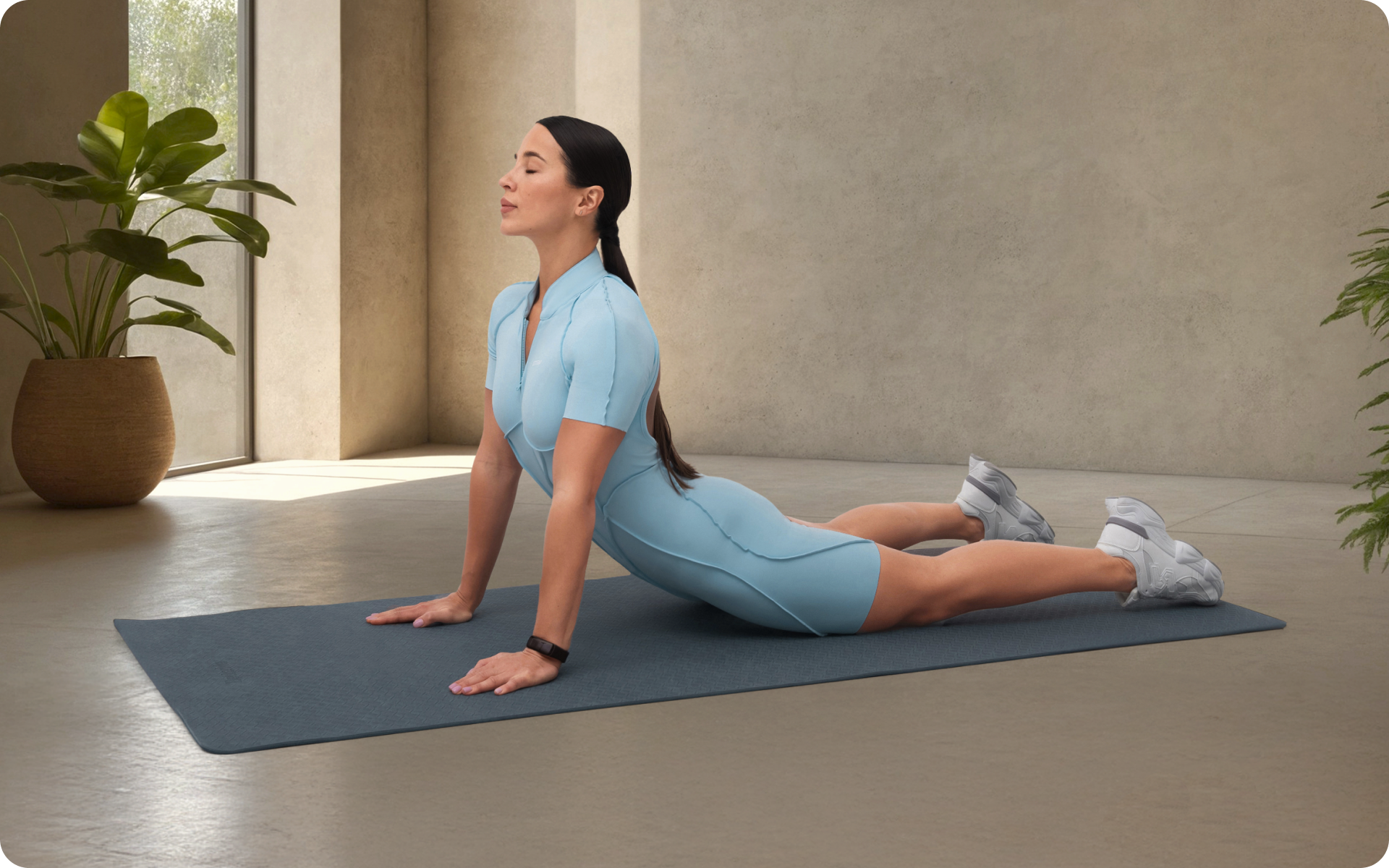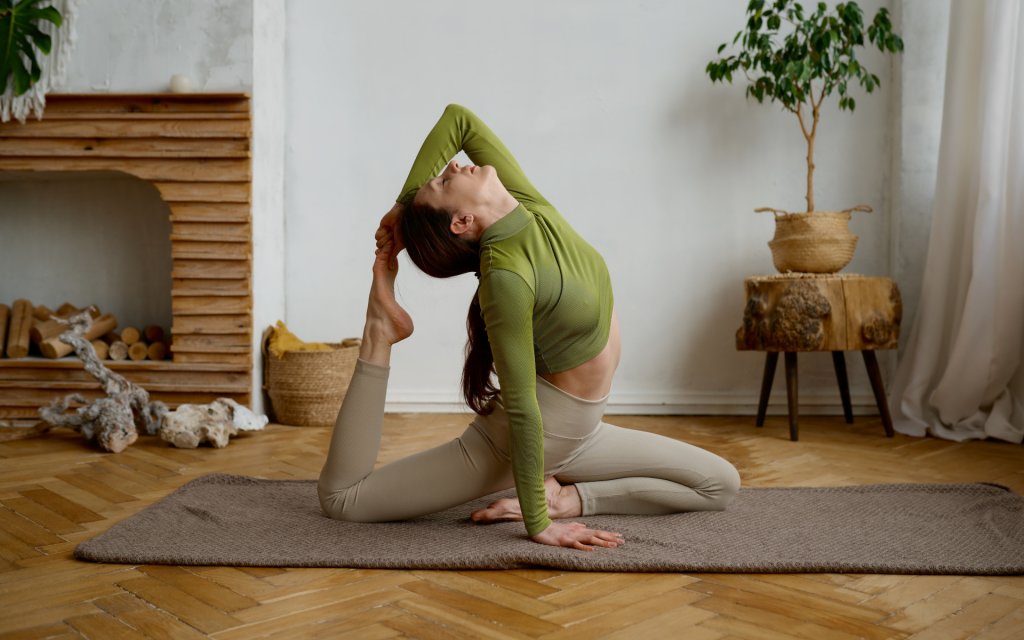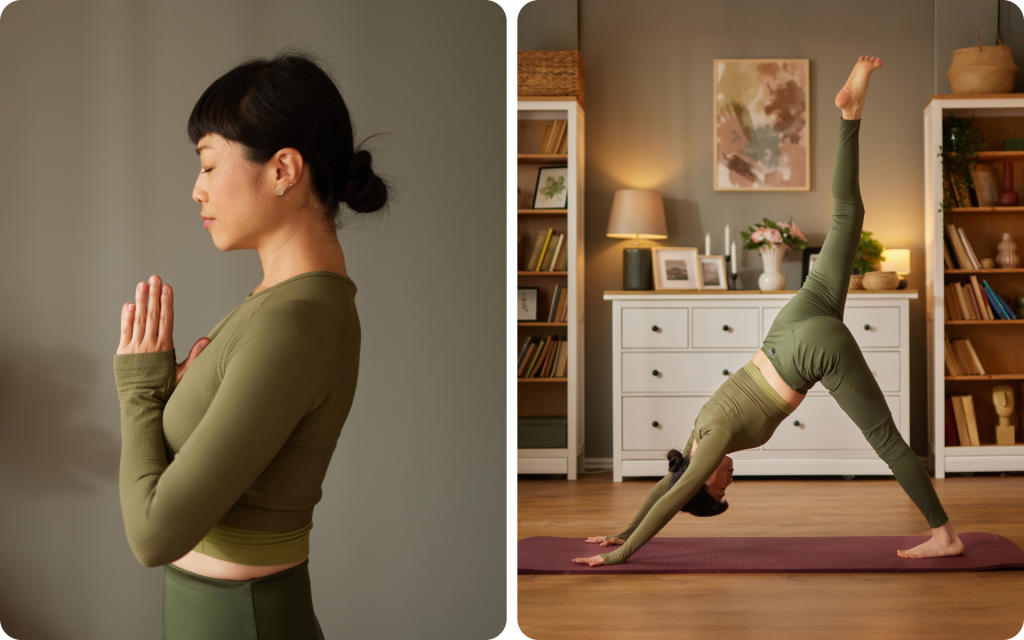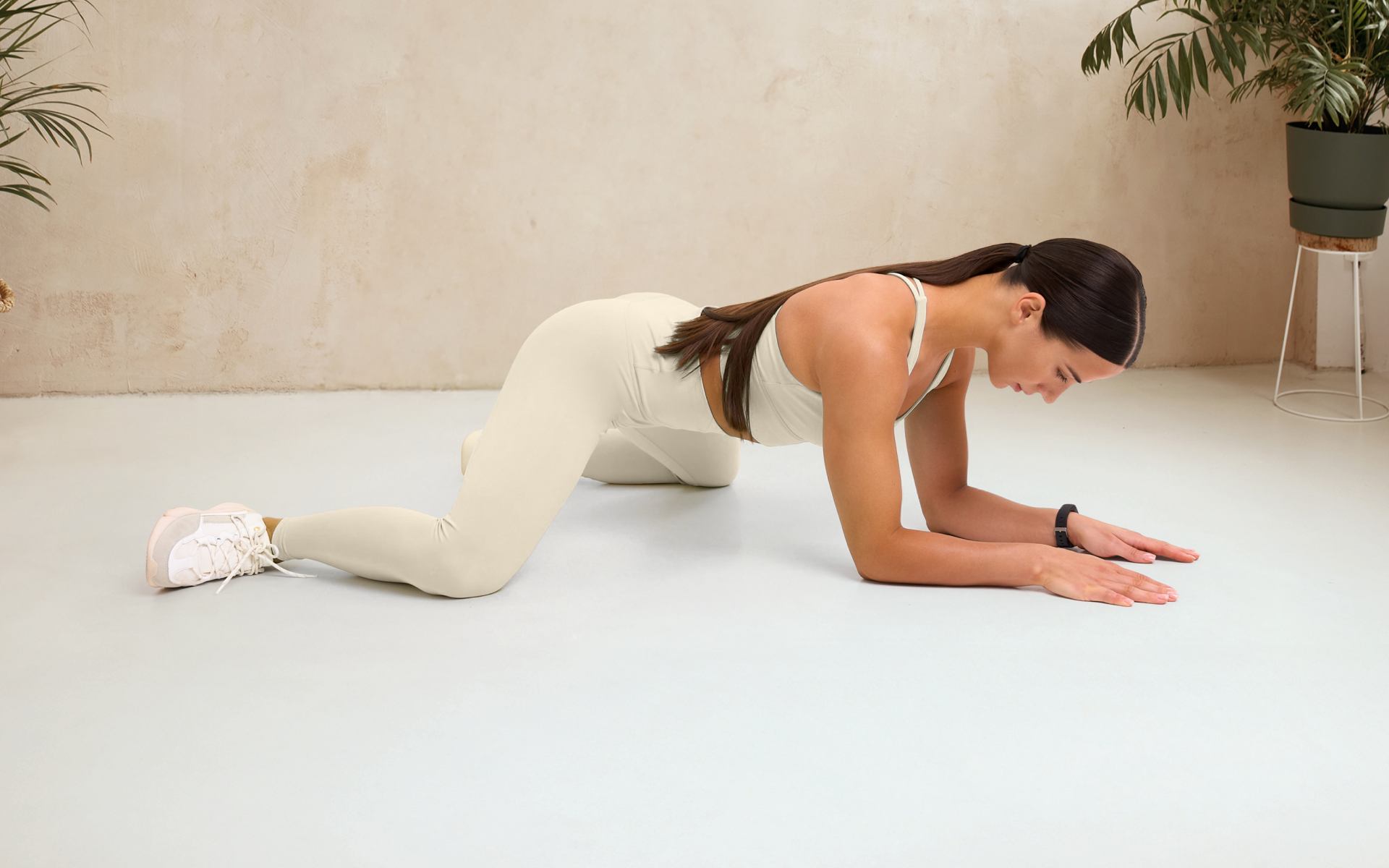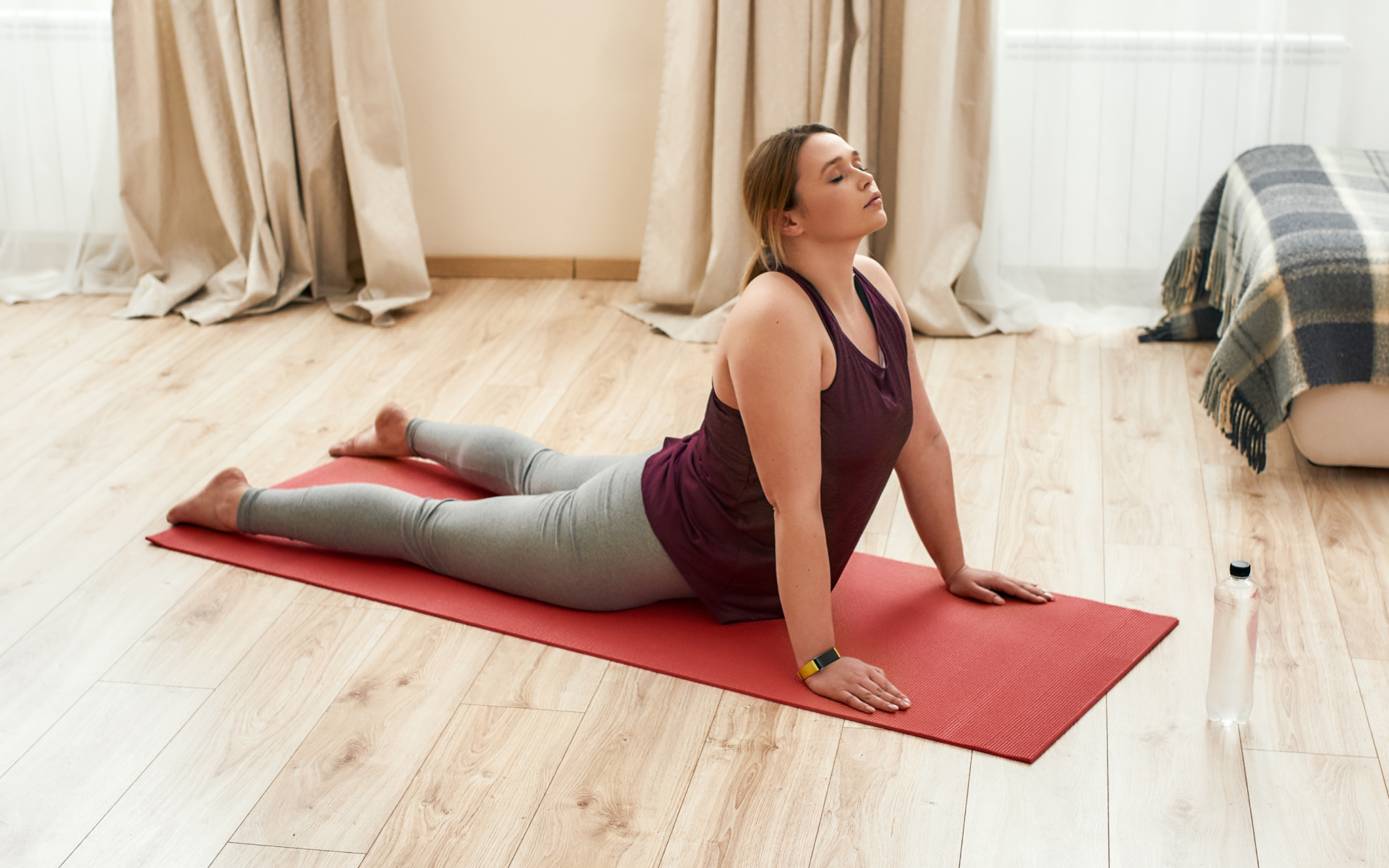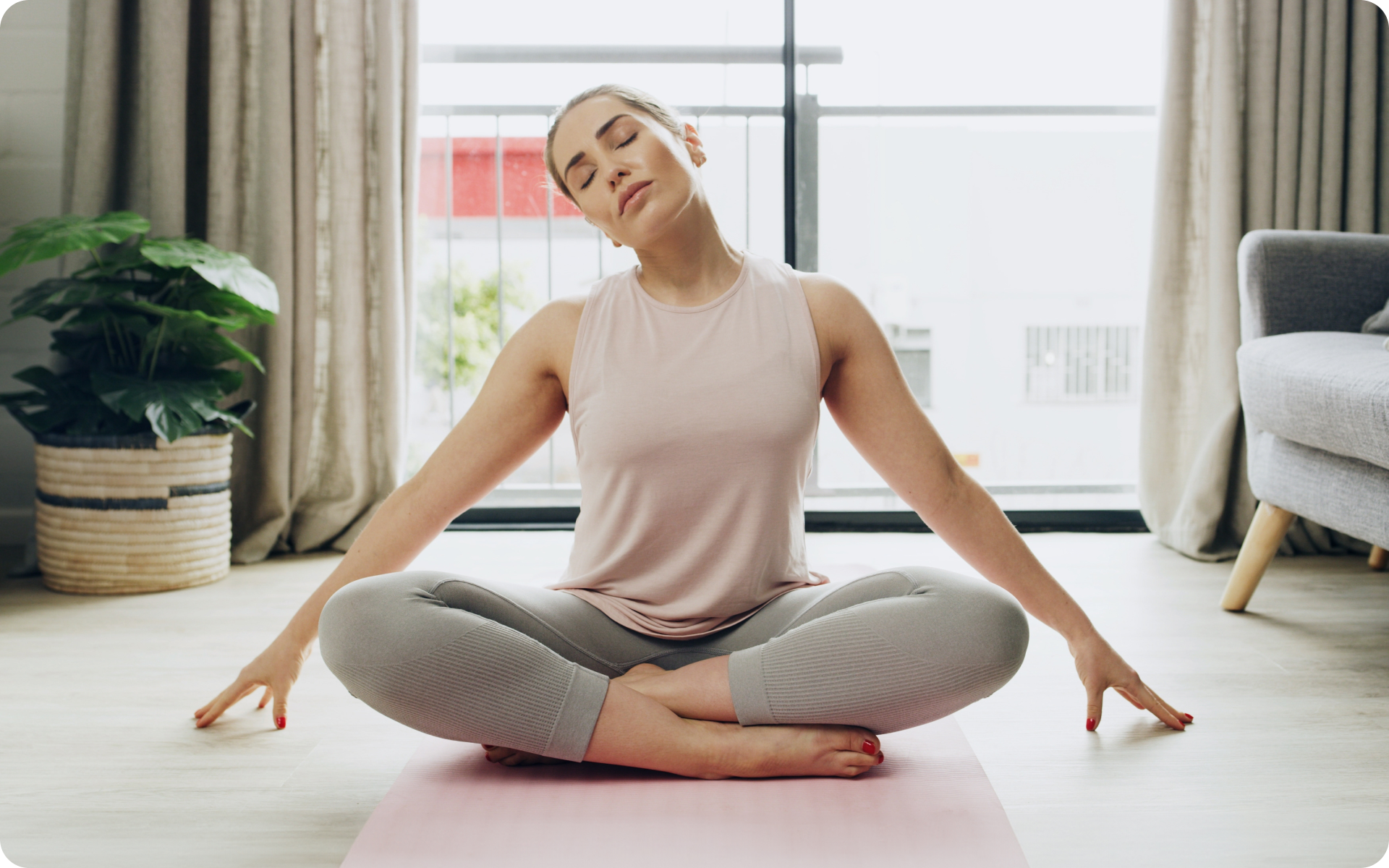With almost one-third of adults worldwide not getting the suggested amount of physical activity or exercise in 2022 (1), it’s more important than ever to rethink how we approach movement and how connected we are to our bodies.
This is where mind-body practices, such as the somatic flexibility technique, come in. This gentle approach uses slow, intentional movements to help release deeply stored tension in the muscles and nervous system (2). Unlike traditional stretching, somatic flexibility offers a unique way to connect with your body’s needs and better tune into its internal signals, allowing you to feel more grounded, relaxed, and physically free.
This article will break down somatic flexibility techniques and their key benefits, plus 5 flexibility exercises to help you begin your journey toward a more relaxed, balanced you.
What Is the Somatic Flexibility Technique?
The somatic flexibility technique is a body-based practice designed to release long-held patterns of tension while helping you reconnect with your body’s natural range of motion and mobility (2, 3).
At the core of this technique is a concept that is known as pandiculation, which is the body’s natural response to releasing tension build-up (4). Often seen as a spontaneous yawn or full-body stretch when waking up, when used intentionally, it involves a conscious contraction followed by a slow release of muscles to return to their resting state (4).
Instead of relying on forceful or repetitive stretching, it uses slow, gentle movements to help you become more aware of how your body feels and moves. Therefore, it may be particularly beneficial for those who are dealing with ongoing muscle stiffness or discomfort due to chronic stress, sedentary habits, or other barriers (5).
In essence, by tuning into your body’s sensations during movement, somatic flexibility can help manage chronic tension while promoting a deeper level of body awareness, supporting your long-term well-being in a sustainable, healthy way.
How Does Somatic Flexibility Differ from Traditional Stretching?
While traditional stretching usually focuses on holding certain poses or pushing muscles to stretch farther, somatic flexibility takes a gentler, more mindful approach by inviting you to slow down and pay closer attention to how your body feels from the inside out.
Rather than forcing a stretch, this approach uses slow muscle contractions followed by a gradual release – similar to the instinctive full-body stretch you may do upon waking up. The goal isn’t to “go deeper” into a pose or increase your performance level but to better listen and connect with your body’s internal needs in the present moment (6).
Reasons why BetterMe is a safe bet: a wide range of calorie-blasting workouts, finger-licking recipes, 24/7 support, challenges that’ll keep you on your best game, and that just scratches the surface! Start using our app and watch the magic happen.
What Are the Benefits of Somatic Flexibility Techniques?
While research on somatic practices is promising, more studies are required to confirm the full range of benefits for all groups of individuals. However, many individuals who engage in these techniques regularly report noticeable improvements in how they feel, both physically and mentally.
Some of the most commonly reported benefits include (5, 7):
- Reduced muscle tension and stiffness
- Improved body awareness and mobility
- Relief from stress and anxiety
- A deeper sense of calm and relaxation
- Better ability to tune into your body’s needs
Which Exercises Are Included in Somatic Flexibility Routines?
One of the most empowering parts of these techniques is that almost any movement or stretch can become a somatic practice, as long as the focus stays on how it feels from the inside rather than how it looks from the outside. It’s less about perfect form or hitting a physical goal and more about noticing the subtle sensations within your body (6).
Many somatic flexibility routines include familiar yoga poses and basic stretches, but they can be easily adapted to fit your needs. Whether lying down, seated, or standing, the focus is to slow down, stay present, and allow your body to guide the pace.
If you’re unsure where to start and need more support, the BetterMe app offers a variety of somatic exercises and tutorials to help you build a routine that supports your body’s natural rhythm.
Read more: Somatic Yoga for Trauma: A Beginner’s Guide to Coping Through Movement
What Are Some Somatic Flexibility Techniques?
If you’re new to somatic flexibility techniques, these gentle exercises are a great place to start – they’re simple, approachable, and generally well-suited for beginners. Still, it’s always a good idea to check in with your healthcare provider before you start any new movement practice, particularly if you’re managing an injury or health condition.
Once you’ve got the all-clear, here are five basic somatic flexibility exercises to help release tension, improve awareness, and deepen your connection with your body (8).
Standing Awareness
Standing awareness is a foundational somatic stretching exercise for beginners, as it doesn’t require any special expertise or prior skills – just a calm, focused mind. The goal is to connect with how your body feels in the present moment without striving for any external or fitness-based outcome.
Here’s how to perform a basic standing awareness exercise (9):
- Stand naturally with your arms hanging by your sides and your feet hip-width apart.
- Close your eyes to eliminate any distractions and bring your focus inward.
- Begin slowly scanning your body or tuning into its internal sensations, starting at your feet and spending about 5-10 seconds on each area.
- Gradually move upward through your body, noticing how each body part feels without judgment or self-criticism.
- As you can, mentally note what you feel, such as “I notice more weight in my left leg” or “My stomach feels tight in the center.”
- Once you finish the scan at your own pace, take a moment to reflect: How do you feel now compared to when you started?
Arch and Flatten
The arch and flatten somatic stretch is ideal if you experience tension in the lower back and pelvis area. For those who sit or stand for long periods of time, this stretch can be particularly beneficial for reconnecting with your spine’s natural range of motion.
Here’s how to perform the arch and flatten stretch (10):
- Lie on your back with your knees bent and your feet flat on the floor, hip-width apart.
- As you inhale, slowly arch your lower back away from the floor.
- As you exhale, gently roll and flatten your back onto the floor.
- Move slowly and gently between these two positions at your own pace, taking moments to notice how your body feels internally.
- Repeat this process for 8 to 10 repetitions or breath cycles, keeping your focus on your body’s internal sensations.
Neck Release
A neck release is a simple stretching exercise that helps ease tension in your neck and shoulders, areas where many people unknowingly hold onto stress. It can be helpful for those who sit for long hours at their desks or have other sedentary lifestyle habits (11).
Here’s how to do a neck release somatic stretch:
- Sit or stand comfortably with your feet flat on the floor, hip-width apart.
- Let your chin slowly drop toward your chest, and pause to notice how your neck feels and any tension that may arise.
- Gently roll your head to the right, bringing your ear toward your shoulder.
- Hold briefly, then return to the center and repeat on the left side.
- Continue for a few rounds, staying mindful not to push or strain your muscles.
- Once finished, take a moment to reflect on how the tension in your neck feels compared to when you first started.
Carpal Tunnel Exercise
Carpal tunnel exercises are beneficial in releasing discomfort or tightness in the wrists and forearms, which is perfect if you spend a lot of time typing or using your hands. It can also help you become more aware of how you hold onto tension in this area.
Here’s how to do a basic somatic carpal tunnel exercise (12):
- Start by lying on your left side with your legs bent in front of you at a 90-degree angle and your head resting comfortably on your left arm.
- Place your right hand on the floor with your elbow bent, allowing your upper arm to rest along your torso.
- Gently lift your right arm over your head, bringing your hand near your left ear, with your right elbow pointing straight up toward the ceiling.
- Guide your head toward the ceiling using your right hand, activating the muscles along the right side of your waist, similar to a side crunch.
- Pause and take a deep breath, noticing any internal sensations.
- Slowly return your head back down and repeat the movement once more.
- From there, keep your right elbow pointing upward and gently roll onto your back, letting your right arm extend behind your head.
- Extend your left arm to the side, then curl your right arm and shoulder toward the left side of your body.
- Ease back down slowly with control, taking time to notice how your body feels.
- When you’re ready, repeat this entire sequence on the opposite side.
If you wish to free yourself from all the extra pounds that have been weighing you down for way too long, start using the BetterMe: Health Coaching app and overhaul your entire life!
Somatic-Based Therapy: A Beginner’s Guide
If you’re looking into seated yoga stretches to do in your chair during work or when you need a break, the seated cat-cow stretch may be a great option. It’s a gentle way to release tension and relax the body without needing to step away from any tasks.
Here’s how to do a seated cat-cow somatic stretch (13):
- Sit on the edge of a sturdy chair with your feet flat and your hands resting on your knees.
- As you inhale, arch your back slightly, lift your chest, and tilt your pelvis forward (cow pose).
- As you exhale, round your spine, tuck your chin inward, and tilt your pelvis back (cat pose).
- Continue this movement slowly 5-10 times, keeping your breathing aligned with each motion.
- Once finished, take a moment to breathe deeply once more and notice any areas of tension or relaxation.
Read more: Somatic-Based Therapy: A Beginner’s Guide
What to Know Before Getting Started with Somatic Flexibility Techniques
Before starting, it’s truly important to realize that somatic flexibility technique exercises aren’t about pushing your body or chasing results. Rather, they’re about slowing down, tuning in, and gently reconnecting with your body’s needs and internal sensations. To get the most out of your practice, here are a few key considerations you should keep in mind.
How Can Beginners Start Practicing Somatic Flexibility Techniques?
Starting a somatic flexibility routine doesn’t require any prior experience or fitness level, just a willingness to slow down and listen to your body. Fortunately, these techniques are easily adaptable to meet your physical needs and abilities, which makes them accessible for beginners with the right mindset and environment.
To set yourself up for a successful somatic practice as a beginner, consider these tips:
- First, consult a healthcare provider, particularly if you’re managing an injury or any ongoing health concerns.
- Choose a quiet, clear space where you can move freely without distractions.
- Wear comfortable, loose-fitting clothing that doesn’t restrict your movement.
- Consider using a yoga mat or soft surface for extra comfort during floor-based exercises and stretches.
- Set an intention for your sessions, whether it’s easing tension, improving your level of self-awareness, or simply finding a deeper sense of calm.
Can Somatic Flexibility Techniques Help with Stress Relief?
Somatic techniques may support stress relief by improving the connection between your mind and body, but research is still ongoing to confirm their full range of benefits (3, 14). By becoming more attuned to how your body feels during movement, you may gradually find it easier to recognize and release built-up tension over time (15).
However, keep in mind that the effects of somatic practices can vary significantly from person to person. For this reason, it’s best to always go at a pace that feels right for you, and don’t hesitate to try different methods until you find what brings the most relief.
Is Equipment Needed for Somatic Flexibility Exercises?
No special equipment is needed to start practicing somatic flexibility exercises. These movements are designed to be simple and adaptable, using only your body, mind, and awareness. However, if you plan to make somatic flexibility exercises a regular part of your routine, the following items may enhance your experience:
- A yoga mat or soft floor padding for floor-based exercises
- Supportive props such as cushions or a folded towel
- Calming music or aromatherapy for added sensory relaxation
- Apps for guided sessions and accountability, such as the BetterMe app
That being said, all of these extras are entirely optional. Your most valuable tools are your full attention and a genuine willingness to listen to your body.
Can Somatic Flexibility Techniques Help with Weight Loss?
Somatic techniques aren’t designed for weight loss or achieving any type of fitness or appearance-based goal. Instead, the primary purpose is to build self-awareness and help you reconnect with your body – how it moves, feels, and exists – without judgment.
However, consistent practice can support healthier habits and a more mindful approach to well-being, which may indirectly aid in weight management over time. However, if you’re specifically seeking somatic exercises for weight loss, it’s important to shift your focus inward and prioritize how you feel, rather than chasing external results.
Yes, somatic flexibility techniques are gentle and easily adaptable to all fitness levels, including for beginners and those with limited mobility. Each movement can be modified to suit your body’s needs and physical abilities. The focus isn’t on how far you stretch, but on tuning into your internal experience and moving with awareness (16). Depending on your goals and personal preferences, somatic flexibility sessions can last anywhere from 5 minutes to an hour or more. Even a brief session can offer immediate relief from tension and stress, while longer sessions allow for a deeper experience or time to engage in multiple techniques. If you’re unsure how long your sessions should last, consult your healthcare provider for further guidance that’s tailored to your unique health needs and goals. While somatic flexibility techniques aren’t designed specifically for athletic training, they can enhance body awareness, ease of movement, and physical recovery, which are all beneficial for improving athletic performance (17). Athletes may find benefits from using these practices for reducing tension, improving mobility, and preventing injury (18, 20). For the best results, you should practice these techniques regularly, but they should never feel like a chore or obligation. Start with a few sessions per week and aim for around 20 to 45 minutes per session, gradually adjusting the frequency until you find a routine that feels natural and supportive (19). Remember to always tune into your body’s signals and adjust your pace as needed.Frequently Asked Questions
Is the somatic flexibility technique suitable for all fitness levels?
How long does a typical somatic flexibility session last?
Can the somatic flexibility technique improve athletic performance?
How often should you practice the somatic flexibility technique?
The Bottom Line
Somatic flexibility techniques offer a gentle, mindful way to reconnect with your body and release built-up tension without needing intense or complex exercise routines. Whether you’re looking for relief from stress, greater mobility, or simply a deeper sense of self-awareness, these practices can support both physical and emotional well-being.
It’s important to remember that the goal isn’t perfection but to build awareness and move with intention. Start slowly, remain consistent, and allow your body to guide you at its own pace.
For more resources to support your well-being, check out the BetterMe app – your go-to destination for tips, tutorials, and personalized guidance for a better, healthier you.
DISCLAIMER:
This article is intended for general informational purposes only and does not serve to address individual circumstances. It is not a substitute for professional advice or help and should not be relied on for making any kind of decision-making. Any action taken as a direct or indirect result of the information in this article is entirely at your own risk and is your sole responsibility.
BetterMe, its content staff, and its medical advisors accept no responsibility for inaccuracies, errors, misstatements, inconsistencies, or omissions and specifically disclaim any liability, loss or risk, personal, professional or otherwise, which may be incurred as a consequence, directly or indirectly, of the use and/or application of any content.
You should always seek the advice of your physician or other qualified health provider with any questions you may have regarding a medical condition or your specific situation. Never disregard professional medical advice or delay seeking it because of BetterMe content. If you suspect or think you may have a medical emergency, call your doctor.
SOURCES:
- Nearly 1.8 billion adults at risk of disease from not doing enough physical activity (2024, who.int)
- How to Release Tension with Somatic Stretching (2024, centrastate.com)
- Mindful Movement: The Evolution of the Somatic Arts and Conscious Action (2016, jstor.org)
- What is pandiculation? (2022, somaticmovementcenter.com)
- The Impact of Stretching Intensities on Neural and Autonomic Responses: Implications for Relaxation (2023, nih.gov)
- Effects of combining physical activity with mindfulness on mental health and wellbeing: Systematic review of complex interventions (2024, sciencedirect.com)
- The simple act of stretching (2021, research.colostate.edu)
- What Is Somatic Stretching? How It Works, Benefits, and Stretches for Beginners (2024, everydayhealth.com)
- Standing Awareness (2019, somaticmovementcenter.com)
- Arch and Flatten (2019, somaticmovementcenter.com)
- The effectiveness of a neck and shoulder stretching exercise program among office workers with neck pain: a randomized controlled trial (2016, nih.gov)
- Exercises for Carpal Tunnel Syndrome (n.d., somaticmovementcenter.com)
- Cat/cow pose (2023, mayoclinic.org)
- Somatic Education: Gentle Exercises for Easier Movement (2009, tandfonline.com)
- Interoceptive Awareness Skills for Emotion Regulation: Theory and Approach of Mindful Awareness in Body-Oriented Therapy (MABT) (2018, nih.gov)
- Holding the body in mind: Interoceptive awareness, dispositional mindfulness and psychological well-being (2017, sciencedirect.com)
- 7 Reasons Why Every Athlete Should Do Clinical Somatics (2019, somaticmovementcenter.com)
- Flexibility and its effects on sports injury and performance (1997, nih.gov)
- Suggested Schedule for Doing Somatic Exercises (n.d., somatics.org)
- Flexibility (n.d., sportsmedtoday.com)
